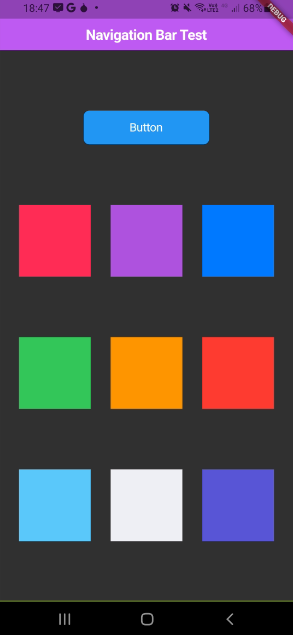Decidi postar a tela que eu tentei replicar no exercício, porém com algumas diferenças de Widgets, porque eu estava lendo a documentação e estou utilizando o Material Design do iOS que no caso é o pacote Cupertino que da pra importar no próprio Flutter.
A minha tela está dessa forma, acrescentando um botão também, segue abaixo:

Código da main
import 'package:flutter/material.dart';
import 'package:flutter/cupertino.dart';
import 'package:flutter_course/home_screen.dart';
void main() {
runApp(const MyApp());
}
class MyApp extends StatelessWidget {
const MyApp({super.key});
// This widget is the root of your application.
@override
Widget build(BuildContext context) {
return MaterialApp(
theme: ThemeData.dark(),
title: 'Flutter Demo',
home: const HomeScreen()
);
}
}
// Container(
// color: Colors.white,
// child: Column(
// mainAxisAlignment: MainAxisAlignment.spaceEvenly,
// crossAxisAlignment: CrossAxisAlignment.center,
// children: [
// Stack(
// alignment: AlignmentDirectional.center,
// children: [
// Container(color: Colors.red, width: 100, height: 100),
// Container(color: Colors.blue, width: 50, height: 50)
// ],
// ),
// Stack(
// alignment: AlignmentDirectional.center,
// children: [
// Container(color: Colors.greenAccent, width: 100, height: 100),
// Container(
// color: Colors.purple.shade400, width: 50, height: 50)
// ],
// ),
// Row(
// mainAxisAlignment: MainAxisAlignment.spaceEvenly,
// crossAxisAlignment: CrossAxisAlignment.center,
// children: [
// Container(color: Colors.purple, height: 50, width: 50),
// Container(
// color: Colors.amber.shade200, height: 50, width: 50),
// Container(color: Colors.cyan.shade300, height: 50, width: 50),
// ],
// ),
// Container(
// color: Colors.amber,
// height: 30,
// width: 300,
// child: Text(
// 'Olá mundo',
// style: TextStyle(
// color: Colors.black,
// fontSize: 25,
// ),
// textAlign: TextAlign.center,
// ),
// ),
// ElevatedButton(
// onPressed: (){},
// child: Text('Aperte o botão!'))
// ],
// ),
// ));
// }
// }


